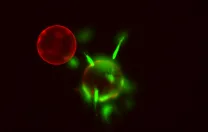As Harvard pursues a broad program of bioengineering research and teaching, one element—based on deciphering life forms and processes, and making novel uses of the discoveries—has made a major advance. On October 7, the University announced that Hansjörg Wyss, M.B.A. ’65, has given Harvard $125 million—the largest donation in its history—for work in “biologically inspired” engineering. A Harvard Institute for Biologically Inspired Engineering (www.hibie.harvard.edu) had already been established in anticipation of Wyss’s support; it will be renamed in his honor.
The official gift announcement (Wyss chose not to publicize it himself) says it is intended to “uncover the engineering principles that govern living things, and use this knowledge to develop technology solutions for the most pressing healthcare and environmental issues facing humanity.” President Drew Faust hailed it as “a transformational investment in powerful, collaborative science.”
The interdisciplinary research program (expected to involve “experimentalists, theoreticians, and clinicians with expertise in engineering, biology, chemistry, physics, mathematics, computer science, robotics, medicine, and surgery from Harvard’s schools and affiliated hospitals, as well as from neighboring universities”) will be directed by Donald E. Ingber, Folkman professor of vascular biology at Harvard Medical School (HMS) and professor of bioengineering in the School of Engineering and Applied Sciences (SEAS). According to Provost Steven E. Hyman, who was interviewed about the announcement, Ingber and McKay professor of bioengineering David J. Mooney led the academic planning within and beyond Harvard that underpins the new institute.
Hyman said that Wyss, who became president of the U.S. division of Synthes in 1977 and drove the company to global leadership as a manufacturer of medical and surgical devices during the ensuing 30 years (he stepped down as CEO in 2007), had “served a role that was unusually positive and inspiring” in shaping the new program. The provost noted that the University had not been particularly engaged in an earlier wave of biomedical engineering. But now, at an “inflection point” where biological science, genetics, information technology, nanomaterials, and other developments in engineering have progressed, Harvard is in a position to combine and augment its strengths in diverse disciplines to pursue a much broader agenda.
Ingber’s work is representative of such opportunities. His laboratory webpage, at Children’s Hospital, describes research into how the “process of tissue construction may be regulated mechanically” using techniques from “molecular cell biology, mechanical engineering, physics, chemistry, and computer science.” Focusing on how blood vessels form, he has made discoveries in “angiogenesis, tissue engineering, mechanobiology, and systems biology,” resulting in credit on patents involving everything from drugs to micromanufacturing techniques and software.
Harvard’s wider interest in bioengineering was most recently articulated in a strategy paper, “Engineering Biology for the 21st Century,” prepared for SEAS and HMS (https://hms.harvard.edu/public/strategy/Bioengineer.pdf). The faculty committee responsible was directed by Joanna Aizenberg, McKay professor of materials science, professor of chemistry and chemical biology, and Wallach professor at Radcliffe, and Pamela Silver, professor of systems biology (see “Seeing Biological Systems Whole,” March-April 2005, page 67). That report envisioned “a focal point of pedagogy and collaborative and translational research”—involving the schools of engineering, medicine, law, business, and public health and engaging problems such as bioenergy (using photosynthesis to capture and store energy); water purification; food supply; and healthcare.
This Harvard University Bioengineering (HUB) program, its authors hoped, would have a minimum of 20 new faculty positions. Importantly, the initiative embraces both research and education—with both an undergraduate concentration and a graduate curriculum—much as the systems-biology program has evolved in recent years. Full implementation awaits the appointment of a permanent SEAS dean; in the meantime, HIBIE’s initial focus—now carried over to the Wyss Institute—is on synthetic biology, living materials, and biological control.
As an element in this broader bioengineering initiative, the Wyss gift jump-starts research and faculty recruiting (the funds will endow seven new positions and the costs of fitting up labs), with Harvard responsible for administrative and facility costs. By providing a core of instruments and facilities for diverse experiments, the Wyss Institute aims to support basic science, clinical research, and collaborations with industry to commercialize products.
Hyman was particularly excited about siting the Wyss Institute alongside Harvard’s efforts in stem-cell science, regenerative medicine, and systems biology—all slated for the new laboratory building now under construction in Allston. There, he said, new work on synthetic biology and on “rebooting or reprogramming cells to deliver therapies” may advance rapidly as scientists interact: “That exactly fits where we want to go.”
The bulk of the Wyss gift is meant to be “spent down” in five years, in pursuit of the research agenda. The hope, the provost said, is that investigators will also be able to secure federal grants for their research—and that the progress will be sufficient to engage Wyss in further support.
The Wyss-funded professorships will obviously advance Harvard’s teaching capacity in bioengineering, Hyman said, but more professors will be needed to fulfill HUB’s ambition to launch a full undergraduate concentration. Thus, in educational terms, Hyman said, the Wyss gift “is a beginning, not the end.”






